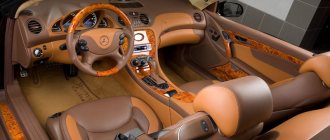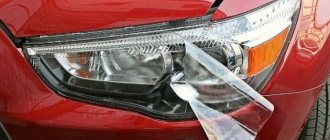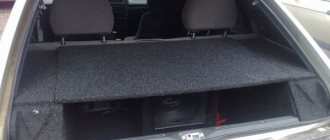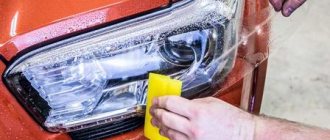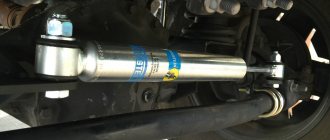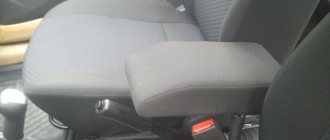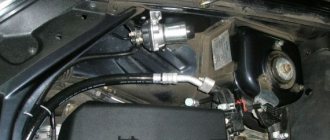When planning to freshen up the interior, many begin to figure out how to glue a car carpet. For updating the interior of a salon, it is an almost ideal option: you can take material of any color, with a variety of pile lengths. In addition, due to the absence of an additional base, the carpet stretches very well (you must not overdo this so that it does not start to show through) and is molded, making it easy to fit parts of more complex shapes.
Another advantage of carpet is its resistance to fading (unlike various fabric materials) and abrasion (which is typical, for example, of suede). And the material will not burst like leather. And if you choose its acoustic version, you can significantly increase the degree of sound insulation in the cabin. In any case, at least for covering the subwoofer, preference should be given to this type of modern material.
How to glue a car carpet: the process is absolutely not complicated and can only be complicated by an ill-considered choice of adhesive mixture.
Reasons to renew your interior flooring
Pasting with carpet is required when the previous coating has worn out. Over time, dust and dirt, mechanical stress lead to a change in the appearance of the coating for the worse. In some places, gaps appear.
Even if the car owner has always paid a lot of attention to the cleanliness of the interior and protected it, time makes its own adjustments. Cleaning saves you from contamination, but it wears out the finishing material.
Usually the reason for the decision to glue new fabric is the desire to update the ceiling or floor covering
It is important to choose correctly what to glue the carpet with, for this you need to decide on the type of fabric, there is fleecy and smooth
Usually the reason for the decision to glue new fabric is the desire to update the ceiling or floor covering.
Fleecy coverings
This type is often chosen for car interiors, sold in rolls, and is considered carpet material. The length of the fibers can be different, the color range is rich. It would be more practical to use dark tones or gray, taking into account the degree of contamination of the floor covering.
It would be more practical to use dark tones or gray, taking into account the degree of contamination of the floor covering.
Smooth surface coatings
Autolin is a type of finishing material that can withstand high loads, but you won’t be able to glue it with your own hands. The technology of work requires skills, so it is carried out by specialists. It is most often chosen for public transport.
Autolin is a type of finishing material that can withstand high loads, but you won’t be able to glue it with your own hands.
Madeleine can stick on its own, it has a self-adhesive base. It's easy to work with.
Madeleine can stick on its own, it has a self-adhesive base.
What glue to use for carpet - an overview of the best options
Working with carpet is really not difficult, the most important thing is to choose the right adhesive composition. Both specialized and universal brands of glue are suitable for covering plastic, metal and wooden parts.
We present the most popular of them:
Aerosol adhesive 888 Ultra reinforced formula (Russia) is a specialized synthetic adhesive that can quickly and reliably glue various materials, such as wood (including plywood), carpet, carpet, leather and leatherette, rubber, plastic in any combination. For ease of application, the can is equipped with a sprayer with an adjustable glue supply.
This innovative, versatile product is capable of permanently bonding a variety of materials. A wide range of operating temperatures (from -40 to +120°C) allows for cladding even in a cold garage. The glue has virtually no drawbacks, except for the price.
A 520 ml can, designed for approximately 3-5 square meters of single-layer application, costs about 700-800 rubles. If you have a large amount of work to do, it makes sense to purchase similar glue in regular liquid form.
Liquid adhesive 88-SA (Russia) is a homogeneous viscous solution of a rubber mixture and modified synthetic resin. With great success, 88 glue is used for gluing carpet, leather and textile materials to plastic, wood, metals, and rubber.
Glue 88-CA forms an elastic seam and is not afraid of water and temperature changes (products can be used at temperatures from minus 50 to plus 60 ° C). The long “life” of the applied adhesive layer greatly facilitates work on large areas.
The 88-CA adhesive contains no toluene or other undesirable solvents. As a rule, 88 is sold in plastic bottles of 0.5 and 1 liter and costs on average 350-450 rubles per kg.
Furniture glue (pink) is a liquid adhesive composition widely used in furniture production for gluing foam rubber. Excellent for gluing carpet to plywood (covering acoustic shelves, podiums, etc.).
This adhesive is not recommended for use on interior roof trim. Liquid furniture glue is available; a liter bottle costs about 350 rubles. Average consumption - 150-200 grams per 1 sq.m.
Today on the market you can also find ready-to-use self-adhesive carpet. It costs more than usual, but it is much more convenient to work with than using glue. The reverse side of the material is coated with a high-quality adhesive mass based on synthetic rubber. Self-adhesive carpet is sold by the meter, supplied in rolls 1.5 meters wide.
Removing scratches on car plastic with a lighter
One of the proven and well-proven ways to eliminate a defect on plastic in the interior is to warm it up with a lighter. To remove a scratch on the plastic inside a car, you will need to acquire a so-called “turbo lighter”. It can be purchased at almost any store, and it has a stable flame, which is critical when removing a scratch.
Note: Often even sellers do not know that they have a “turbo lighter” in stock, but it is so. Ask to see all the lighters and you need to choose the one in which the red part of the flame is practically invisible and the fire appears blue.
To remove a scratch from plastic in a car using a lighter, you need to bring it to the problem area and press the button several times in a row. Do not keep the flame burning for a long time; one press is enough (that is, the flame will burn for no more than a second). This is necessary to uniformly heat the surface of the plastic, both in the deformed area and around it. Over time, the plastic will warm up and the scratches will heal.
Important: When removing scratches on interior plastic using a lighter, it is not recommended to touch the heated material. This is due to the fact that the plastic will seriously soften, and a simple touch with a finger can deform it.
It is worth noting that the method of removing scratches in the car interior using a lighter is effective only if smooth plastic is used. When it has a relief, it is better to choose another method, since heating the plastic can lead to deformation of the structure
Suitable adhesive options
Depending on the quality of the surface, the product is selected. Some people prefer to combine formulations.
Glue 88. Has a strong chemical smell and is difficult to erode. Does not tolerate high temperatures well. Covering the floor is the best option, but covering the panel does not make sense, since it melts under direct sunlight. It tolerates shaking well in the car. For application, you can use a regular paint brush.
PVA. There are mixed reviews. In the cold it loses its elasticity, which limits its scope of application. Not recommended for dark-colored carpet - it can leave white marks if the material is not used carefully and stretched. Apply with a brush. Does not tolerate humid atmosphere.
Moment. It has a wide range of different varieties. The price for a small tube is high. Most often it has the consistency of a paste, so it is difficult to apply to a large surface. Optimal use of the spatula. The paste hardens quickly, so you need to work quickly.
Import. There are lines from many foreign manufacturers. Recommended by experienced craftsmen. They are consumed minimally and are distributed with a spray gun. Resistant to temperature changes. However, they belong to a high price category.
Aerosol. Reviews are mixed. Be careful when choosing, as a wide range of glues can lead to confusion. The temperature on the cylinder must be above 40 degrees at a constant fastening time
When facing, it is important to cover two surfaces with the composition. The aerosol spray becomes temporary when applied to one surface.
Titanium
It has a liquid structure, odorless and colorless. One of the advantages is the noticeably low cost. Titanium is a strong composition, but does not have good elasticity.
The listed means are the most popular. When working, it is customary to combine all options. For example, different adhesives are used for floors and ceilings.
What to glue
The material is fixed simply if you choose the right glue or adhesive base. There are several types of glue, and it is selected depending on the type of surface.
The most inexpensive is 88 glue. Its advantage is price and elasticity. As a rule, this property is useful when working with large, not too rigid areas that are prone to vibration - ceilings, trunk lids, door panels. But it has a very significant drawback - it does not tolerate high temperatures, so it is better to avoid using it on surfaces that are constantly exposed to the sun.
PVA can also theoretically be used, but with great caution, since light adhesive spots often appear, spoiling the appearance of the surface, and after hardening, the composition loses its elasticity.
The moment is not for everybody. It holds well, but has a specific smell and requires quick application and fast and precise application of the pattern to the surface.
Furniture. It is used if its temperature conditions are known. As a rule, it does not like high and low temperatures, although it will glue the carpet firmly.
The most expensive is specialized glue (Jowat, Kleiberit). It is heat-resistant, elastic, odorless, and easy to use.
Many people use adhesives for ceiling tiles: Titan, Energoflex, as well as nameless compounds from furniture production, but, of course, there is no guarantee.
How to work with carpet
Thanks to its durable composition and good moisture resistance, carpet is ideal for car interior treatment, as well as for subwoofers and speaker systems.
In order to cover the interior of a car with carpet yourself, you do not need to have any special skills, you just need to follow the clear instructions.
First you need to prepare all the available tools:
- carpet fabric;
- glue;
- scissors;
- hair dryer;
- rollers.
After preparing all the parts, you can start covering with carpet:
1. When purchasing carpet, pay attention not only to the color and density of the fabric, but also to its width. If the width is insufficient, you will have to adjust another roll of carpet, which can cause joints to form, which looks unsightly
Also, the fabric should stretch well in different directions.
2. Along with purchasing carpet, also purchase glue. The glue must not only be highly durable, but also heat-resistant. Many stores that sell this kind of fabric have special aerosol adhesives.
3.Remove as many removable parts as possible from the car interior - sills, door handles, etc.
4. Clean all surfaces from dirt, and run the degreasing mixture over the plastic. It is worth noting that before work, the surface must be completely dry.
5.Apply glue to the treated surface (several layers are possible), then treat the carpet itself. After the glue has dried (at least 20 minutes), lean the carpet against the surface. Try to get exactly in the right place, and also make sure that there are no uneven spots or bumps.
6. It is better to start upholstering the interior with parts of a simple shape, then more complex ones. At the end, it’s worth starting with the elements upholstered with fabric (car doors, ceiling, etc.).
7. To cover more complex shapes, prepare a piece of carpet sewn from several parts of fabric. The overall size of the piece should be slightly smaller than the part being processed, but keep in mind that slightly less, this means that when stretched it will become exactly the right size for the part.
8.When the carpet is laid, heat it with a hairdryer
It is important to note here that when heated, the glue sets better, and so does the carpet, so you must be sure that the canvas lies flat and in place
These were instructions for covering the interior with carpet, from which you learned the basic principle of working with the canvas
It is also important to say that the moment with the choice of glue is very important, since it is precisely this that ensures the reliability of the mounted canvas, so try to choose high-quality glue for the carpet
How to glue car carpet
Let's look at the process of gluing carpet using the example of re-upholstering a car ceiling using 888 Ultra series aerosol adhesive:
We dismantle the ceiling trim. To do this, remove the decorative plugs and unscrew all the existing screws. We place the ceiling on a large table so that there is no sagging. If there are peelings or oil stains on the old coating, they must be cleaned, degreased and dried. We lay out (try on) the carpet, cut off the excess material, leaving 7-10 centimeters on each side for the hem. Fold one half of the fabric. Shake the can of glue thoroughly for 10-15 seconds. Turn the nozzle to the desired spray angle. Apply glue in an even thick layer from a distance of 15-20 centimeters to the base and carpet. Uneven application of glue is fraught with the formation of “bubbles” and bumps that will ruin the entire work. We maintain a technological pause for 30-60 seconds. We begin to firmly press the surfaces to be glued together, moving from the middle to the edges
It is important to push through every centimeter of the car carpet to achieve the best result. Bonding occurs immediately after compression. All that remains is to wait until it dries completely (a day or two depending on the temperature and humidity in the room). We reinstall the ceiling trim.
To prevent the sprayer from becoming clogged, and the glue remaining in the can can be reused, immediately after completing the work, turn the can upside down and spray the composition again until the gas begins to escape - it will blow through the nozzle. Excess glue can be cleaned with a solvent.
Instructions - how to glue carpet to plywood and plastic
Let's look at the process of gluing carpet using the example of subwoofer casing using liquid glue 88-CA:
We start by preparing the surfaces to be glued:
- We cut carpet;
- We prime the entire surface of the box to be glued (coat it with an even thin layer of 88-CA glue, wait until the glue is absorbed into the wood and dries)
- Apply glue in an even thick layer using a rubber spatula on the base, and with a brush on the carpet.
- We maintain a technological pause for 2-3 minutes.
- We perform gluing by smoothing and pressing the fabric tightly to the body.
- The glue dries completely after 24 hours; after this time, you can install the speakers in the box and install the equipment in the car.
VIDEO INSTRUCTION
Task: installing sound insulation for a Lada Priora car in the “Gold” configuration
The first thing we decided to do for complete sound insulation was to cover the roof of the VAZ car. We carefully remove all unnecessary elements from the roof, including the sheathing on the roof of the vase. Now you can make the first layer of sound insulation on the car ceiling. We install a high-quality damper from SGM Alumast Alfa to neutralize vibration on the vase roof. How much work does this cost us? You yourself can guess by the appearance of the roof in the photo and the effect achieved. The roof of the Lada Priora is not only protected from vibrations, but has also become stiffer. The use of vibration on the roof significantly reduces the overall sound background in a hatchback car. Then you need to make another layer on the roof. For this purpose we use a thick layer of Violon WELL sound insulator. It eliminates unwanted sounds. After installing it, it is almost impossible to push through the roof of the car, and raindrops will definitely not cause any discomfort to anyone. After assembling the upper part of the interior and hatchback of the car, all we have to do is take on the lower part to achieve a similar effect.
Covering the trunk with carpet.
To cover the trunk with carpet, you need to take the following set of materials and tools:
- Three linear meters of carpet 1.5 m wide;
- Special glue;
- Brush for applying glue;
- Scissors;
- Plastic sealing roller.
First of all, we disassemble and thoroughly wash the luggage compartment, not forgetting to first remove the old upholstery. It is best to glue each part of the trunk separately, and then simply assemble all the components together. If you plan to glue it in one piece, then you need to buy one meter more carpet.
We dilute the glue according to the instructions on the package (if necessary). Apply the adhesive liquid with a brush to the plastic or metal parts of the trunk. We start gluing from one corner, carefully gluing all the irregularities. The material fits well, so there is no need to apply excessive force. After pasting all the elements with carpet, you need to walk over their surface with a plastic roller. The advantage of this finish is the visual absence of joints and seams at the junction of the parts.
Pasting technology
The fabric must be cut before starting work. The bend allowance is 3 cm. It is glued to the old surface or after dismantling. With strong adhesion of the old skin, the carpet will hold firmly.
Each glue has its own operating technology:
- If you use glue that is not resistant to high temperatures, then you need to apply a thin layer of the composition with a paint brush, wait a couple of minutes, and cover with a layer of new carpet. It takes a day for good adhesion.
- Aerosols are applied at a distance of 15 cm from the surface. Exposure - 1–3 minutes. Press down. You can use the car within 24 hours.
- The glue, which activates its properties after exposure to high temperature, is applied in 5 layers. After each application there is a break of 20 minutes. Material is applied on top. There is dry glue on both surfaces, so it is easy to move the carpet. After placing the pattern in the desired place, a hairdryer heats the material. The composition melts under the influence of temperature. All that remains is to press and smooth. Gradual heating leads to uniform adhesion.
Vibration insulation of the floor, trunk and rear arches of the Lada Priora photo
Now we disassemble, thoroughly clean and degrease all surfaces on the floor in the cabin, after which we install noise and vibration insulation on the floor, trunk and arches. How many layers will be required for this installation? This tariff involves installing Shumka on the floor and arches in the cabin in two layers. At the first level, we lay the material on the floor of the Lada Priora hatchback that we have been working with for a long time and successfully. The properties of Alumast Alfa are worth talking about separately. It is plastic and fits tightly to the floor of the car hatchback. That's why we roll it everywhere, even in the most problematic places on the car floor. On top of it we install another layer of insulation. The most suitable material for this purpose, Bibiton, is laid on top of the vibration on the floor. It is worth saying about it that it is a special foam rubber impregnated with polymers and mastic. On the mounting side it has silicone protection. It absorbs as much airborne noise penetrating through the arches and floor of the car as possible. It has high anti-corrosion characteristics, so the car is now protected from rust. This equipment does not require additional sound insulation inside the interior and hatchback of the Lada Priora. The next step will be to cover the arches and trunk of the Lada Priora
Carefully disassemble the lower part of the hatchback car to get to the arches. Then we wipe and degrease the surfaces of the arches
To dampen the arch, we use the same Alyumast, which does not put extra weight on the trunk and arches of the car. We cover the arches and trunk with another layer of Shumka, for which we use an adhesive-based vialon. The arches and trunk should be well worked on to make the interior of the vase almost silent. For the arches here we did everything we could, and we also covered the niche for the spare tire with Uniton. Now the arches and trunk are completely protected from fungus. And visually, as can be seen in the photo, the arches are in harmony with the trunk. We cover the trunk lid of the vase in the same way as the hood. How the materials are cut can also be seen in the photo.
Do-it-yourself soundproofing of the engine shield priors. Shumka VAZ 2170. Gluing
I won’t beat around the bush and start with the fact that the article talks about how to soundproof the engine shield on a Priora.
I bought my Lada Priora in 2012. I try to correct all its factory defects myself. So I decided to do the soundproofing under the instrument panel myself. Fortunately, the sound insulation technology is not much different from other car brands.
The insulation will absorb the noise coming from the car's engine, thereby making the trip a comfortable journey.
I will say right away that the process of installing such sound insulation is very labor-intensive - it takes about two days, but the result is worth it. Before starting work, you need to make sure the room is well lit.
We will need:
- 4 sheets of Vibration Isolation (brand and name of your choice)
- 2 square meters of Accent or SPLEN
- 1 square meter Madeline (for winding wiring)
Installation steps
Removing the panel (dashboard). In order to install sound insulation on any car, you must first clear the space where the Shumka will be installed. This means you have to remove the front panel of the car, and this is a very difficult process.
- When dismantling, the most important thing is not to confuse all the bolts and screws that secure the panel. Therefore, it is better to put them in different bags and sign them. You can draw a schematic plan for the location of the screws.
- We remove the car dashboard very carefully so as not to scratch or break it.
- We remove the factory noise.
- For convenience, it is better to sign all the parts so as not to get confused during the assembly process.
Surface preparation. Before proceeding with the actual installation of sound insulation, it is necessary to completely clear all dust and debris, and also degrease the entire working surface. Then you can get to work.
Installation of vibration insulation. The process of installing sound insulation begins with a vibration-proofing layer (the first layer of sound insulation). To do this, you can use a special self-adhesive material - Vibroplast, Vibrofilter. You can use bitumen-based material Vizomat. It is laid on the surface in medium-sized pieces. This material must first be heated with a hairdryer. Place it on the surface, press it tightly and roll it out with an iron roller. The next sheet is laid in a similar way, only overlapping the first one. This way the entire surface is covered.
Nowadays, a huge number of materials have appeared on the soundproofing market. There are cheaper analogs of Vizomat. Not inferior in quality. For example, SGM products, STP Bombs and many others.
Laying sound insulation (second layer). For Shumka, sound-absorbing materials such as Accent, Vibroton or Spleen are usually used. Laying one of these materials did not take me much time, since the materials have a self-adhesive backing. The entire surface must be covered without exception. The sound insulation layer should not be less than 8 mm.
Wire insulation
To complete the soundproofing of the engine shield, you will have to pay attention to the wiring. Although they are tightly attached there, it is still advisable to wrap them with anti-squeak self-adhesive material - Anti-squeak or Madeline
Reinstalling the panel. This is the last step in installing soundproofing, but not the easiest. Now we have to put everything in its place. The wires will take up most of the time; they need to be laid out correctly.
mens-auto.ru
What is the material
Automotive carpet differs in structure, thickness, and has different ductility. The cheapest fabric for upholstery is made from fiber, the density of which per square meter does not exceed 450 g. Many car owners prefer to upholster the interior from a material made from polypropylene. The length of the pile in this type of carpet reaches 6 mm.
The soft premium fabric, which is based on double-twisted polypropylene fiber, lasts a long time, looks elegant and rich.
Carpet has a lot of advantages compared to other materials used to upholster car interiors:
- Absorbs noise.
- Does not absorb dirt, does not collect dust.
- Does not electrify, does not burn out.
- Keeps you warm.
Although the fabric is made from synthetic fibers, it does not cause allergies and does not irritate the skin or respiratory tract. Carpet covers the ceiling, the inside of the trunk, the subwoofer, and acoustic shelves. The material does not become moldy and does not deteriorate from moisture.
The fabric is available in different shades, does not fade, and is highly wear-resistant.
It is distinguished by increased flexibility of madeline, which is most often used to line the trunk. Car enthusiasts like the material because:
- easy to glue:
- has a beautiful smooth surface;
- retains heat.
Carpet is inexpensive, but absorbs noise in the cabin. The floor in the car is often covered with linoleum, which adheres well, does not lag behind moisture, can withstand overloads, but is deformed when sand or solid particles accumulate.
Removing small cracks
The following tools allow you to quickly eliminate minor cracks and at the same time preserve the condition of your wallet. Their effectiveness is based on the principle of polishing and preparatory work should consist of thorough cleaning of the surface being treated and its further drying.
Wax
Wax is used to polish plastic surfaces. It must be used in combination with soft, dry cloth. Movements during rubbing should be circular. A cotton swab will help get rid of excess wax. A good alternative to wax is GOI paste or machine oil.
Glass cleaning products
Glass cleaning products must be used according to the same principle. In combination with a dry cloth, the action of such compositions is quite effective in relation to minor scratches.
Glass polishes
Products used for polishing glass surfaces with abrasive components are also suitable for plastic. In the case of small scratches, this method not only masks them, but removes them completely. Hydrofluoric acid can act as an abrasive component, so if there are elements on the surface that are not made of plastic or glass, refrain from using this option.
Polish for copper and silver
Copper and silver polishes can be used in tandem with microfiber or a dry cloth. Rubbing should be continued until the trace of cracks is visually invisible.
Household or construction hair dryer
A household or construction hair dryer will allow you to quickly deal with a minor defect. Be sure to clean the surface and dry it. Start heating the area with the scratch with a hairdryer, but do not hold it in one place. Wait until the plastic begins to melt slightly. Do not touch the restored surface with your hands until it has cooled down.
Computer products
Tools for computer equipment and disks also demonstrate effectiveness. They are also convenient to use in combination with microfiber.
Polish for wood and plastic surfaces
Wood polish will also work on plastic, but it should be combined with Vaseline. The damaged area will be filled with this composition and the crack will not be so visible. Continue rubbing the surface until the Vaseline is completely absorbed.
Using Dye
Minor scratches can be dealt with with a dye designed specifically for masking this type of damage. It should be applied with a toothpick or thin brush. Polishing is carried out with machine oil.
You can find more detailed information on how to choose the right paint for plastic in the article by our specialist.
Fabric paint or masking markers
Fabric paint or masking markers are also effective, but require additional finishing polishing. Felt pens, if their quality is beyond doubt, can be quite expensive, but this method is very economical.
Some gluing features
Fixation technology is selected for each composition separately. Aerosols are sprayed above the surface at a distance of 15 or 20 cm and held for at least 60 seconds. Glue that is not used at high temperatures is applied to a brush, the base is lubricated, and after 2-3 minutes it is connected to the fabric. The product, the effectiveness of which increases when heated, is applied in several layers, each left to harden for a quarter of an hour. A cloth is glued on top and the hairdryer is turned on. The substance melts and adheres evenly.
To plywood
The subwoofer housing can also be covered with carpet. The material is laid out and cut, leaving allowance for folding. The plywood body is treated with liquid glue 88-CA. After the composition has been absorbed and dried, the same product must be put on a brush and lubricated with carpet, and applied to the wood with a staple.
After 3 minutes, the material must be pressed firmly against the body, and the glue will harden, but it will take a day to dry. After installing the speakers, the speaker system is installed in the car.
To plastic
Before covering any part of the interior, a piece of carpet is measured and cut. The material is laid out on a cleaned and dried surface. The smooth plastic coating is treated with fine-grained sandpaper, disinfected with a thinner, and anti-silicone is applied to avoid glue build-up.
Experienced craftsmen do not recommend wiping the steering wheel with a solvent containing acetone before reupholstering, since when the temperature rises, aggressive vapors entering the microfiber destroy the top layer of the carpet. To clean plastic, it is better to use Molecule thinner.
If there is old material left on the coating, it is not necessary to strip it off. Liquid glue 88 or Furniture glue is applied with a roller or brush in a thin layer, after a couple of minutes the carpet is pressed to the work surface. The composition dries completely within a day. The aerosol is sprayed onto the underside of the material, when the solvent has evaporated, the casing is fixed to the plastic. Thermoactive glue is applied to both surfaces to be joined in 5-6 layers, each one is heated with a hairdryer. The carpet is pressed and held until the temperature of the composition drops.
Additional tips and tricks
If you decide to save money and glue the carpet yourself, then you should know some tips from professionals. If you use glue with a strong odor, you need to remove the parts and glue them in a room with good ventilation. Do not rush to install the parts in place; it will take three days for the smell to disappear.
If you use glue with a strong odor, you need to remove the parts and glue them in a room with good ventilation.
You can renew the coating in the car interior yourself; it is important to choose the right fabric, as well as an adhesive. The best option would be to choose a self-adhesive carpet, which is easy to work with; the appearance of the new coating will please you for a long time
Where to buy carpet?
Such an offer from an unknown seller who does not yet have any reputation sounds twice as suspicious. Such fly-by-night entrepreneurs may offer low-quality material that will fade or wear out after a couple of months of use. Poor-quality carpet may stretch poorly or tear during gluing.
Our company sells different types of branded carpet at low prices. These products are manufactured by well-known companies that provide a guarantee on all their products. There are regular and self-adhesive auto carpets on sale in different shades: white, black, beige, white and others. Reasonable prices and good quality - our range is based on these two pillars.
What is the price
Prices for Russian material start at 200 rubles. The most expensive domestic soundproofing material will cost 550 rubles per linear meter. It is usually sold in rolls, the width of which is one and a half meters. The direct competitor to the domestic one is the Chinese brand Mystery. For it you will have to pay from 400 to 600 rubles per meter, and the Chinese roll is 10 cm narrower than ours.
Adhesive-based fabric is more expensive and its price starts from 700 rubles. The roll width can be 1500 mm, and a 700 mm roll of self-adhesive costs about 500 rubles. This type is more elastic, stretches well, is simply cut and quickly glued to the prepared base. Italian, Turkish and Polish materials are also on sale. Among the expensive ones is the finishing of the Stinger company. They ask for it from a thousand per linear meter. This type of carpet is elastic, has different thicknesses and densities, and is available in a wide range of colors.
Gray carpet.
Gray carpet is the most popular upholstery shade. Excellent for gluing racks and other elements, covering the floor in the trunk or the car interior itself. The material is not easily soiled, does not accumulate dust, and is easy to clean with a vacuum cleaner. Noble gray color is the best pair for any shade of armchair upholstery. It goes harmoniously with both bright and pastel colors.
Gray carpet is produced in two versions: melange and plain. The first is a mixture of fibers of dark and light shades. The result is an unusual, as if “dusty” color of wet asphalt or graphite. No traces of dirt are visible on this coating. The appearance of the gray autocarpet always remains presentable and intelligent.
For car interiors in black and other dark colors, we recommend choosing a darker gray. Light melange looks decent even in a white car. There are a lot of options and combinations. This shade allows you to easily mask the joints of the material and always makes a favorable impression.
What upholstery material to choose
Some drivers cover the ceilings with leather or leatherette, auto vinyl, or carpet. But we recommend that you use auto velor. This material looks very beautiful and is pleasant to the touch. The modern market offers us a wide variety of automotive velor. Choose stretch velor with a large cell structure. It looks like 3D carbon film and is very practical to use. Such car velor practically does not get dirty, and minor dirt can be easily removed.
As for the color of the future ceiling, we recommend choosing calm pastel shades. You should not give preference to bright white color - it is too easily soiled and will very soon turn into a dirty gray rag. It will be easier for you to work with materials in discreet tones, since flaws are not visible on them. In addition, bright colors distract the driver from the road, irritate and tire the eyesight. When choosing a shade of material for the ceiling, remember - it must be combined with the colors of other interior elements.
How to cover with carpet?
Upholstering the interior of a car with carpet with your own hands is quite simple. To do this, you do not need to have special skills or knowledge. All you need is a little patience, as well as the availability of the necessary materials and tools:
- Carpet (regular or self-adhesive);
- Scissors;
- Roller;
- Roulette;
- Glue;
- Hairdryer (construction or household).
The technology of applying carpet involves preliminary cleaning of the surface from the remains of old cladding, dirt and dust. All possible unscrewing and removable parts are disconnected and pasted over separately. You need to be extremely careful with self-adhesive fabric to avoid the appearance of air pockets. Before gluing a regular carpet, special glue is applied to the surface of the car interior.
You need to start gluing panels and parts from one corner and gradually moving towards the center. At the end of finishing, walk over the glued surface with a special roller. This will smooth out any possible unevenness in the fabric.
Car interior reupholstery with carpet: instructions
What set of equipment is needed to repair auto glass?
The work will go quickly and successfully if you follow the correct algorithm for its implementation. The interior trim is done according to the following instructions:
- Using a thin brush, carefully spread the composition over the surface to be treated. Then you need to wait about two minutes until the solvent evaporates.
- Pre-prepared patterns are applied.
- The carpet is pressed against the surface and held until it sets with the base.
It takes about a day for complete setting. Until this time, we do not recommend touching the treated area.
Cleaning the surface before applying car carpet must be done thoroughly. If dirt is not completely removed from it, adhesion between surfaces will be minimal. To properly glue the carpet into a car, we recommend watching a video tutorial and clearly understanding the principle of operation:
Car carpet is a special automotive material for upholstery of a car interior. Carpet is used to make upholstery for carpets, change the factor of the ceiling, dashboard, subwoofer trim, etc. Autocarpet is produced in all parts of the world and produces different colors, thicknesses, pile lengths, operational and external characteristics.
Soundproofing of the instrument panel (dashboard) with removal
We will need:
- 2 days of free time
- 3-4 meters of Biplast (you can use Bitoplast)
- 1-2 meters Madeline
- Roller (optional)
The first step is to disconnect the terminal on the battery. Next we will have to remove the panel. During the removal process, it is better to sketch or mark where which bolt and nut were removed from
Carefully pull the wiring out of the connectors. Each plug has a locking mechanism
Be sure to degrease the entire surface.
Lada Priora uses cheap plastic, which is the source of noise. Therefore, it is necessary to glue the joints and contact points of the plastic using vibration-proof materials. Such materials can be bitoplast or modelin. The latter material is used for tight spaces. Bitoplast allows you to work with large gaps, up to 1 cm. In addition, it has good sound absorption characteristics, so if you cover all the panels with it, you can further muffle the noise of the motor. Anti-squeaks, in addition to the dashboard, should be glued to those places that will come into contact with other elements of the interior and the engine shield.
To make air flows measured and intense, it is recommended to cover the air ducts in the same way, as well as all the instrument wiring of the machine.
If you have removed the panel, then take advantage of the opportunity to soundproof the engine shield
Wrapping process
- Everything that is accessible for dismantling is removed before covering with carpet. It’s more convenient to work this way, and the material lays out more evenly.
- The surfaces are washed, cleared of paint (again, if there is any left), dried, sanded and degreased. For plastic ones, gasoline can be used as a solvent;
- A piece of the required size is cut from the roll with a small margin. If there are difficult places on the part (for example, a lampshade on the ceiling), the workpiece is applied to it and either a cross-shaped cut is made in the right place, or a hole is slightly smaller than required;
- The workpiece is covered with a thin layer of glue - it will act as a primer;
- After the application has dried, the surface is coated again. Some adhesives require similar processing of the carpet itself - you should read about this in the instructions for the composition;
- The material is applied to the part and leveled with a rubber roller so that there are no air bubbles left under the covering;
- You need to work starting from the middle and moving towards the edges, similar to how you work when gluing wallpaper;
- The edges curl underneath. If they are too long, they are trimmed and fixed on the wrong side;
- Certain difficulties can be caused by elements that have a complex configuration - with protrusions and depressions. Before gluing them, the carpet needs to be additionally prepared;
- A pattern is made from thick paper, repeating the outlines of the fitted part;
- The carpet is cut according to the pattern with a margin of 2-3 cm on all sides;
- The material is well sprayed with water from a spray bottle;
- The workpiece is stretched onto the part; on the reverse side you can temporarily secure it with tailor's pins.
Read more: Xenon ban in Russia 2018
After drying, it will be stretched in the right places, which will ensure that the carpet tightly fits all the bumps and depressions. To speed up drying, you can use a household hair dryer. The workpiece should be removed carefully so that it retains its shape, and immediately glued. In order for you to finally understand how to glue a car carpet and gain some skills, you need to start with the least complex parts.
Door inserts or thresholds are ideal for training - their shapes are the most primitive, and you can grasp the principle of the upcoming work with minimal effort and loss.
The material has good noise-absorbing properties, is antistatic, resistant to moisture, and is perfectly moldable. They are used to cover surfaces of various shapes - car doors, acoustic shelves, trunk, ceiling, podiums, panels, subwoofers.
Carpet is available in different colors; the material does not fade over time, and its dense non-woven structure ensures high wear resistance and durability of the coating.
Adhesive compositions: common features and differences
Modern adhesive compositions for plywood are complex mixtures that include not only an adhesive component, but also various additives.
More on this a little later, but for now the basic division of the compositions:
- Protein glues. This is a large group of environmentally friendly adhesives obtained from products and components of animal origin.
The fundamental principles are:
- compositions obtained from milk, or rather a dairy product - cottage cheese. Milk contains the protein casein, which has excellent adhesive properties, once the curd is defatted. This glue is sold as a water-soluble powder;
- compositions obtained from animal blood, more specifically from albumins. They are called albumin, they are water-soluble, designed for hot gluing of parts;
- combined mixtures are distinguished in which both components are present.
- Synthetic analogues involve numerous formulations based on formaldehyde resins.
Among them there are two large subgroups:
- containing urea. This composition is good because it is considered the least toxic and is widely used in everyday life, when gluing various products. The seam obtained during the joining process is colorless and does not change the color of the base material and the part being glued;
- containing phenols. These compounds are toxic, but are highly water resistant. In addition, unlike protein adhesives, they are not damaged by bacteria.
Our help! All synthetic adhesives are designed in such a way that, in addition to resins, they contain solvents, fillers, plasticizers and antiseptics. This entire complex comes into play when the composition is applied to parts and comes into contact with air.
The hardening time and application technology are different for each composition. Instructions for use for each glue are individual.
How to properly remove scratches from gloss
Transparent plastic is used in the design of many interior elements. The disadvantage of this material is the rapid appearance of defects: small scratches and chips, after several years of operation of the car, literally cover the entire surface of the interior element. Removing scratches from car interior plastic has a number of nuances:
Before carrying out restoration, you need to wet clean the car interior. It is necessary to ensure that there is no dust. Otherwise, new scratches may appear on the surface during polishing. The area to be treated will need to be thoroughly washed and degreased. To get rid of scratches, use a sanding machine. To polish the damaged area, it is recommended to use products that are designed for polishing plastic. These are special polishes and abrasive pastes
It is important to correctly calculate the amount of substance applied.
Numerous defects, scratches, chips and cracks spoil the appearance of the car dashboard. Damage of this kind can be easily repaired on your own. To ensure that the repair process is effective and does not lead to replacement of the part, take into account the nuances of restoring the plastic elements of the interior.
Why do you need glue for carpet?
Carpet glue is needed when the fabric does not have a sticky base.
Special glue ensures high-quality smoothing of the fabric over the surface, as well as reliable fixation of the carpet. Poor quality or incorrectly selected adhesive can cause poor sizing of the car interior, as well as contribute to untimely wear of the finishing material. When choosing aerosol adhesive for carpet or liquid in cans, you should pay attention to specially designed products that will fully fulfill their main functional purpose. As a rule, such goods are sold by well-known global and domestic companies that have managed to establish themselves on the positive side
